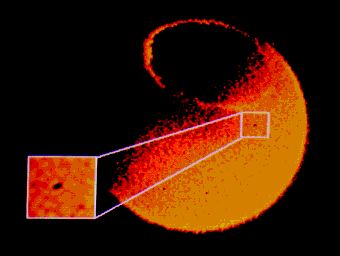86. Small Comets
Photographs taken from Earth-orbiting satellites show small, ice-filled comets striking Earth’s upper atmosphere at an average rate of one every three seconds.a [See Figure 34.] Each comet adds 20 – 40 tons of water to Earth’s atmosphere. If this influx began when evolutionists say the Earth started to evolve, all our oceans would have come from small comets. No doubt past impact rates were even greater, because the planets have swept many of these comets from the solar system. Therefore, small comets would have placed much more water on Earth than is here today. Obviously, this did not happen, so oceans look young. [See also pages 310 and 320.]

Figure 34: Small Comets. The Dynamic Explorer satellite took this picture in ultraviolet light showing small comets (the dark spots) colliding with Earth’s upper atmosphere. The comets begin to break up 800 miles above the Earth’s surface, then frictional heating vaporizes the pieces and their descent stops at an elevation of about 35 miles. The water vapor, which soon dissipates, blocks ultraviolet light from Earth, producing the dark spots. The northern lights are shown by the halo.